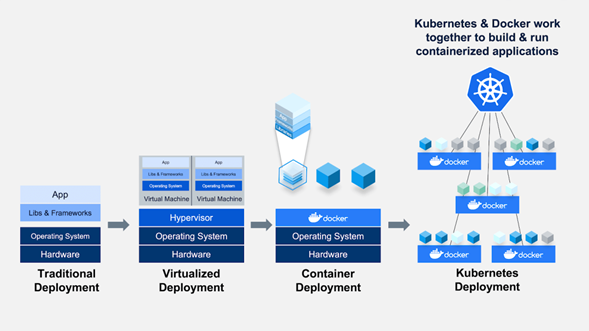Kubernetes as a container or microservice platform that orchestrates computing, networking, and storage infrastructure workloads. Because it doesn’t limit the types of apps you can deploy (any language works), Kubernetes extends how we scale containerized applications so that we can enjoy all the benefits of a truly immutable infrastructure. The general rule of thumb for K8S: if your app fits in a container, Kubernetes will deploy it.
What are the benefits of kubernetes?
Less resources, cost savings
More containers can be deployed on the same host than traditional virtual machines. The demands on the startup process and disk space are lower and faster.
Easier IT management, increased IT productivity
The creation of containers allows you to standardize your deployments as they are repeatable environments for development, test and production tasks. Compatibility with all deployment systems eliminates valuable setup time. They are fully portable items. With Docker, deployment is done in seconds.
Multiple independent applications on the same host.
Each application runs in its container or container cluster independently, without conflicting with the other applications hosted by the host that will run through their own containers. This ensures a safe and efficient environment.

Docker and Kubernetes.
Docker is a lightweight containerization technology that has gained widespread popularity in the cloud and application packaging world. It is an open source framework that automates the deployment of applications in lightweight and portable containers. It uses a number of the Linux kernel’s features to sandbox processes into configurable virtual environments.
Docker is used to running software packages called "containers". A container is a normalized unit of programming that bundles up a code and every one of its conditions, so the application runs rapidly and reliably from one computing environment to other. Containers are the "fastest developing cloud-enabling innovation technology" since they speed the conveyance of programming and cut the expense of working it. Composing programming is quicker, conveying it is simpler and running it requires less equipment and backing.
Kubernetes utilizes Docker to run images and manage containers. The platform itself can be deployed inside practically any infrastructure like Google Cloud, Microsoft Azure, AWS or private network. It is noteworthy that Kubernetes supports the automatic placement and replication of containers over a large number of hosts. It brings a number of features and which can be thought of as:
As a container platform
As a microservices platform
As a portable cloud platform and a lot more
Here are the essential features of Kubernetes:
Offers automated scheduling
Self-Healing capabilities
Automated rollouts & rollback
Horizontal Scaling & load balancing
Application-centric management
Auto-scalable infrastructure
You can create predictable infrastructure
Provides declarative configuration
Deploy and update software at scale
Offers enviroment consistency for development,testing and production

How do we implement Kubernetes at DigitalBranding Ltd?
Kubernetes has become a standard for container management, providing the resources needed to efficiently manage large-scale containerized applications.
Within Digital Branding Ltd we have opted for this technology for the deployment of our web services, such as websites, databases, web applications or hosting, making use of the advantages of autoscaling, monitoring and allowing us to offer our customers 100% operation of their web solutions and minorizing security flaws.
Modern cloud-native architectures are on the rise, but at the same time they bring new challenges, making it a technology with a great future.
Kubernetes